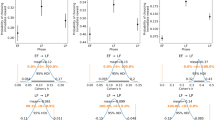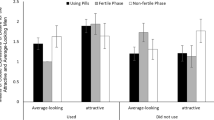Abstract
According to the ovulatory shift hypothesis, women’s behavior near ovulation changes in ways that will enhance mating opportunities. In this study, the relationship between the ovulatory cycle and financial decision-making was investigated. We hypothesized that fertile women, compared to non-fertile women, would exhibit steeper discounting in a monetary choice task, i.e., they would prefer smaller, sooner rewards over larger, later ones, in order to secure resources that could be used for mating purposes. One hundred college-aged women who were normally ovulating and not on hormonal contraceptives completed a monetary choice task along with measures of three forms of impulsivity: nonplanning, motor, and financial. Conception risk was assessed in two ways, by discrete cycle phase windows and by a continuous measure. Results indicated that both fertility and financial impulsivity predicted future discounting. Neither nonplanning nor motor impulsivity influenced discounting. There was no interaction between impulsivity measures and conception risk, suggesting that fertility and impulsivity have independent effects on future discounting. The findings are consistent with the ovulatory shift hypothesis in showing that women’s economic behavior, particularly their preferences for acquiring resources now rather than later, is related to their fertility status. This behavior might be adaptive in that it could help women to gain resources that could enhance their appearance in the service of attracting potential mates or deterring rivals.

Similar content being viewed by others
References
Ainslie, G. (1975). Specious reward: a behavioral theory of impulsiveness and impulse control. Psychological Bulletin, 82, 463–496.
Cohen, J., Cohen, P., West, S. G., & Aiken, L. S. (2003). Applied multiple regression/correlation analysis for the behavioral sciences (3rd ed.). Mahwah: Lawrence Erlbaum.
Durante, K. M., Griskevicius, V., Cantu, S. M., & Simpson, J. A. (2014). Money, status, and the ovulatory cycle. Journal of Marketing Research, 51, 27–39.
Durante, K. M., Griskevicius, V., Hill, S. E., Perilloux, C., & Li, N. P. (2011). Ovulation, female competition, and product choice: hormonal influences on human behavior. Journal of Consumer Research, 37, 921–934.
Durante, K. M., Li, N. P., & Haselton, M. G. (2008). Changes in women’s choice of dress across the ovulatory cycle: naturalistic and laboratory task-based evidence. Personality and Social Psychology Bulletin, 34, 1451–1460.
Fields, S., Collins, C., Leraas, K., & Reynolds, B. (2009). Dimensions of impulsive behavior in adolescent smokers and nonsmokers. Experimental and Clinical Psychopharmacology, 17, 301–311.
Gangestad, S. W., Haselton, M. G., Welling, L. L. M., Gildersleeve, K., Pillsworth, E. G., Burriss, R. P., Larson, C. M., & Puts, D. A. (2016). How valid are assessments of conception probability in ovulatory cycle research? Evaluations, recommendations, and theoretical implications. Evolution and Human Behavior, 37, 85–96.
Gangestad, S. W., & Thornhill, R. (1998). Menstrual cycle variation in women’s preference for the scent of symmetrical men. Proceedings of the Royal Society B, 262, 727–733.
Gangestad, S. W., & Thornhill, R. (2008). Human oestrus. Proceedings of the Royal Society B, 275, 991–1000.
Gildersleeve, K., Haselton, M. G., & Fales, M. R. (2014). Do women’s mate preferences change across the ovulatory cycle?: a meta-analytic review. Psychological Bulletin, 140, 1205–1259.
Goodman, E., Adler, N. E., Kawachi, I., Frazier, L., Huang, B., & Colditz, G. A. (2001). Adolescents’ perceptions of social status: development and evaluation of a new indicator. Pediatrics, 108, E31.
Green, L., & Myerson, J. (2004). A discounting framework for choice with delayed and probabilistic rewards. Psychological Bulletin, 130, 769–792.
Hardisty, D. J., & Weber, E. U. (2009). Discounting future green: money versus the environment. Journal of Experimental Psychology: General, 138, 329–340.
Haselton, M. G., Mortezaie, M., Pillsworth, E. G., Bleske-Rechek, A., & Frederick, D. A. (2007). Ovulatory shifts in human female ornamentation: near ovulation, women dress to impress. Hormones and Behavior, 51, 40–45.
Kaighobadi, F., & Stevens, J. R. (2013). Does fertility status influence impulsivity and risk taking in human females? Adaptive influences on intertemporal choice and risky decision making. Evolutionary Psychology, 11, 700–717.
Kirby, K. N., & Finch, J. C. (2010). The hierarchical structure of self-reported impulsivity. Personality and Individual Differences, 48, 704–713.
Kirby, K. N., Godoy, R., Reyes-Garcia, V., Byron, E., Apaza, L., Leonard, W., Perez, E., Vadez, V., & Wilkie, D. (2002). Correlates of delay-discount rates: evidence from Tsimane Amerindians of the Bolivian rain forest. Journal of Economic Psychology, 23, 291–316.
Kirby, K. N., Petry, N. M., & Bickel, W. K. (1999). Heroin addicts have higher discount rates for delayed rewards than non-drug-using controls. Journal of Experimental Psychology: General, 128, 78–87.
Koff, E., & Lucas, M. (2011). Mood moderates the relationship between impulsiveness and delay discounting. Personality and Individual Differences, 50, 1018–1022.
Lucas, M., & Koff, E. (2013). How conception risk affects competition and cooperation with attractive women and men. Evolution and Human Behavior, 34, 16–22.
Lucas, M. M., Koff, E. K., & Skeath, S. (2007). Pilot study of relationship between fertility risk and bargaining. Psychological Reports, 101, 302–310.
Madden, G. J., & Johnson, P. S. (2010). A delay-discounting primer. In G. J. Madden & W. K. Bickel (Eds.), Impulsivity: the behavioral and neurological science of discounting (pp. 11–37). Washington, D.C.: The American Psychological Association.
McLeish, K. N., & Oxoby, R. J. (2007). Measuring impatience: elicited discount rates and the Barratt Impulsiveness Scale. Personality and Individual Differences, 43, 553–565.
Mobini, S., Grant, A., Kass, A. E., & Yeomans, M. R. (2007). Relationships between functional and dysfunctional impulsivity, delay discounting and cognitive distortions. Personality and Individual Differences, 43, 1517–1528.
Necka, E. A., Puts, D. A., Dimitroff, S. J., & Norman, G. J. (2016). Other women’s fertility moderates female resources distribution across the menstrual cycle. Evolution and Human Behavior, 37, 387–391.
Patton, J. H., Stanford, M. S., & Barratt, E. S. (1995). Factor structure of the Barratt Impulsiveness Scale. Journal of Clinical Psychology, 6, 768–774.
Pepper, G. V., & Nettle, D. (2013). Death and the time of your life: experiences of close bereavement are associated with steeper financial future discounting and earlier reproduction. Evolution and Human Behavior, 34, 433–439.
Pine, K. J., & Fletcher, B. C. (2011). Women’s spending behavior is menstrual-cycle dependent. Personality and Individual Differences, 50, 74–78.
Ramos, D., Victor, T., Seidl-de-Moura, M. L., & Daly, M. (2013). Future discounting by slum-dwelling youth versus university students in Rio de Janeiro. Journal of Research on Adolescence, 23, 95–102.
Reimers, S., Maylor, E. A., Stewart, N., & Chater, N. (2009). Associations between a one-shot delay discounting measure and age, income, education, and real-world impulsive behavior. Personality and Individual Differences, 47, 973–978.
Reynolds, B., Ortengren, A., Richards, J. B., & de Wit, H. (2006). Dimensions of impulsive behavior: personality and behavioral measures. Personality and Individual Differences, 40, 305–315.
Saad, G., & Stenstrom, E. (2012). Calories, beauty, and ovulation: the effects of the menstrual cycle on food and appearance-related behavior. Journal of Consumer Psychology, 22, 102–113.
Stricker, R., Eberhart, R., Chevailler, M., Quinn, F. A., Bischoff, P., & Stricker, R. (2006). Establishment of detailed reference values for luteinizing hormone, follicle stimulating hormone, estradiol, and progesterone during different phases of the menstrual cycle on the Abbott ARCHITECT analyzer. Clinical Chemistry and Laboratory Medicine, 44, 883–887.
Wilcox, A. J., Dunson, D. B., Weinberg, C. R., Trussell, J., & Baird, D. D. (2001). Likelihood of conception with a single act of intercourse: providing benchmark rates for assessment of post-coital contraceptives. Contraception, 63, 211–215.
de Wit, H., Flory, J. D., Acheson, A., McCloskey, M., & Manuck, S. B. (2007). IQ and nonplanning impulsivity are independently associated with delay discounting in middle-aged adults. Personality and Individual Differences, 42, 111–121.
Acknowledgments
Both authors contributed equally to this work. Support was provided by an internal Wellesley College Research Grant. We are grateful to Molly McNamara for her valuable research assistance.
Author information
Authors and Affiliations
Corresponding author
Rights and permissions
About this article
Cite this article
Lucas, M., Koff, E. Fertile Women Discount the Future: Conception Risk and Impulsivity Are Independently Associated with Financial Decisions. Evolutionary Psychological Science 3, 261–269 (2017). https://doi.org/10.1007/s40806-017-0094-8
Published:
Issue Date:
DOI: https://doi.org/10.1007/s40806-017-0094-8




